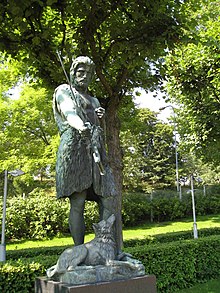Kullervo

Kullervo is a tragic character from the Finnish national epic Kalevala .
The Kullervo legend
The Kullervo legend is written down in songs 31-36 of the Kalevala .
The brothers Untamo and Kalervo get into a dispute over fishing grounds and farmland. Untamo and his men defeat Kalervo in battle and kill all of his sex except for a pregnant woman, who shortly afterwards gives birth to Kalervo's son Kullervo. Attempts are made to kill the boy. After three failed attempts at murder, Untamo decides to let Kullervo work as a slave in his house. Kullervo turns out to be unsuitable and is sold to Ilmarinen , where he is supposed to herd the cattle. Ilmarinen's wife bakes a stone in Kullervo's bread out of malice. While cutting, the blade of his knife breaks, whereupon Kullervo swears revenge and drives the cattle into a swamp. To do this, he drives home predators that kill Ilmarinen's wife. Kullervo flees and learns that his parents and sister are still alive. He finds his parents' house and hears that his sister has disappeared.
Kullervo was sent by his father to pay taxes. On the way back he meets his sister without recognizing her and seduces her. When the sister learns the truth, she drowns herself in a rapids. Kullervo returns home in despair and also wants to commit suicide, but his mother stops him. He then decides to take revenge and kills Untamo and his family. After returning home, he finds his parents dead. He looks for the place in the forest where he seduced his sister and throws himself into his sword.
Parallels in other literatures
The figure Kullervo shows parallels to the hero of the Estonian epic Kalevipoeg , as well as to the Hamlet legend and the Hercules myth. Kullervo also shows parallels to the figure of Oedipus.
Aftermath

.
- The Finnish composer Jean Sibelius processed the Kullervo legend in 1892 in the symphonic poem Kullervo .
- Leevi Madetoja wrote the symphonic poem Kullervo op.15 in 1913 .
- 1915 wrote JRR Tolkien , the story The Story of Kullervo , the 2015 by Verlyn Flieger is annotated edition by HarperCollins published.
- The Finnish composer Armas Launis composed the opera Kullervo in 1917 .
- The composer Aulis Sallinen created the opera Kullervo from 1986 to 1988 , which premiered in Los Angeles in 1992.
- Veljo Tormis created the choral piece Kullervo's Message ( Kullervo sõnum ) in 1994 .
- Helsinki has the Helsingin Kullervo football club .
German translations
Apart from the German editions of the entire Kalevala , the Kullervo cycle has also appeared separately twice:
- The story of Kullerwo. Six songs from the ›Kalewala‹. Transferred by Gisbert Jänicke. Frankfurt am Main: Insel-Verlag 1964. 87 pp.
- The story of Kullerwo. Six songs from the ›Kalewala‹. Transferred and edited by Gisbert Jänicke. Leipzig: Insel-Verlag 1985. 97 pp.
Well-known namesake
- Arvi Kullervo Lind (* 1940), Finnish journalist
- Kullervo Manner (1880–1939), Finnish politician
Secondary literature
- Kustavi Grotenfelt: The say by Hermanarich and Kullervo, in: Finnisch-Ugrische Forschungen III (1903), pp. 45–61. [1]
- Adriaan van der Hoeven: The Making of Kullervo, in: Finno-Ugric Folklore, Myth and Cultural Identity . Proceedings of the Fifth International Symposium on Finno-Ugric Languages in Groningen, June 7-9, 2011. Ed. Cornelius Hasselblatt , Adriaan van der Hoeven. Studia Fenno-Ugrica Groningana 7. Maastricht: Shaker 2012, pp. 73-93.
- Gisbert Jänicke : Kalewaland. The Finnish epic and the problem of epic translation . Hamburg: Buske 1991. (Writings from the Finland Institute in Cologne, vol. 15)
- Kalevalan kulttuurihistoria . Toimittaneet Ulla Piela, Seppo Knuuttila, Pekka Laaksonen. Helsinki: Suomalaisen Kirjallisuuden Seura 2008.
- Kaarle Krohn : Kalevala Studies VI. Kullervo. Helsinki: Suomalainen Tiedeakatemia 1928. ( Folklore Fellows' Communications 76)
- Wilhelm Schott : About the Finnish legend of Kullervo, in: Treatises of the Prussian Academy of Sciences, Philosophical-historical class . Berlin, 1852, pp. 209-236. [2]
- Eemil Nestor Setälä : Kullervo - Hamlet. A comparative test of legend. I. The Nordic versions of Hamlet; II. Assumed isolated versions of the Hamlet saga, in: Finnisch-Ugrische Forschungen III (1903), pp. 61–97. [3]
Web links
Individual evidence
- ^ German text on Wikisource
- ^ Cornelius Hasselblatt : Kalevipoeg Studies. The Creation and Reception of an Epic. Helsinki: Finnish Literature Society - SKS 2016, p. 50. (Studia Fennica Folkloristica 21)
- ↑ Eemil Nestor Setälä: Kullervo - Hamlet. An attempt to compare legends, in: Finnish-Ugric Research III (1903), pp. 61–97.
- ↑ See Alexandre Büchner. L'hercule de l'Esthonie . Caen: type. de F. le Blanc-Hardel 1865.
- ↑ Despite the use of the same translator, the two editions are not textually identical.